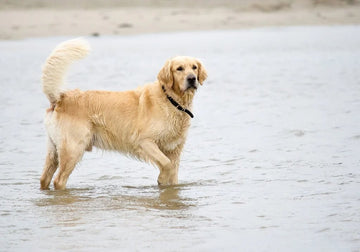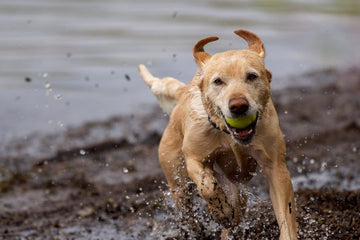
Florida’s coastal landscapes are more than just scenic—they’re symbols of the state itself. With over 100 miles of beach access in Florida State Parks, the Sunshine State offers everything from sugary white sands along the Emerald Coast to coquina-lined stretches on the east and driftwood-dotted shores out west. It’s no surprise that many feel drawn to the shore–humans and pets included.
Bringing your dog along can be a fun, memorable experience filled with splashing in the surf, sandy naps, and tail-wagging adventures. However, just like with any outdoor activity, it takes thoughtful planning to ensure everyone stays safe and respectful of the space.
Florida’s Beach Beauty Is Meant to Be Shared—Safely
The beach is a fantastic place for dogs to burn off energy, cool off in the water, and explore new sights and smells. But not every spot is suitable—or even legal—for pets.
The good news? Florida has no shortage of dog-friendly beaches. With preparation, you and your pup can enjoy the same postcard-worthy views featured in the state’s most iconic parks, all while being good stewards of the natural environment.
Know Before You Go: Dog-Friendly Beach Access in Florida
Not every beach in Florida is dog-friendly, and rules can change by the season. Before packing up your beach bag, check with local ordinances or park websites to confirm current pet policies. Here are a few beloved dog-friendly beaches across the state:
-
Fort De Soto Dog Beach (Tierra Verde): A fenced-in area that lets pups roam leash-free right on the shore. It's part of a larger park that includes shaded picnic areas and dog showers, making it a full-day outing for pet families.
-
Jupiter Dog Beach (Palm Beach County): Over 2 miles of shoreline open to leashed dogs and their owners. This stretch is maintained by a local group of volunteers who encourage responsible pet ownership to keep the beach clean and accessible.
-
Honeymoon Island State Park (Dunedin): Offers a dedicated pet beach where dogs are welcome on leashes. Nature trails and scenic coastal views make this a favorite destination for pet parents who enjoy walking and spotting wildlife along the shore.
-
Brohard Paw Park (Venice): The only dog-friendly beach in Sarasota County, complete with doggie drinking fountains and rinse stations. A gated play area separates the beach from the parking lot, adding peace of mind for owners before heading to the sand.
Before heading out, also consider the tides, surf conditions, and heat index. Check if the area requires dogs to be on leash and be prepared to follow all posted signage. These simple checks help your trip go smoothly and without incident.

Beach Safety Essentials for Your Pup
While your dog may love romping through the surf, beaches present hazards that require preparation. Strong surf, rough terrain, such as sharp shells or debris, and scorching sand can all lead to injury or discomfort. In hot weather, dogs are especially prone to overheating, and crowded beaches can sometimes overstimulate pets. Here’s what to pack and plan for:
-
Hydration: Always bring fresh water and a collapsible bowl. Saltwater can dehydrate and upset your dog’s stomach.
-
Paw Protection: Hot sand can burn paws. Touch the sand with your own hand—if it’s too hot for you, it’s too hot for them.
-
Shade and Rest: Offer shaded areas with a beach umbrella or small pop-up tent. Avoid letting your dog overexert under the sun.
-
First Aid Kit: Include items for minor scrapes, stings, and irritation—especially from shells, jellyfish, or rough sand.
-
Swimming Safety: Not all dogs are natural swimmers. Use a dog life vest, especially in areas with strong currents or waves.
-
Mental Stimulation: Bring beach-safe toys like treat tumblers or plush floatables to keep your dog mentally engaged and prevent boredom.
With these essentials—plus enough food and a few favorite treats—your pup can enjoy the beach safely while you relax with peace of mind.
Mind Your Manners: Beach Etiquette With Dogs
Being a responsible dog owner also involves respecting the natural environment and fellow beachgoers. Even the most well-behaved pets can get overstimulated by all the new sights, smells, and sounds, which can lead to rowdy or unpredictable behavior that may make others—yes, even fellow pet parents—uncomfortable. A few etiquette basics go a long way:
-
Leash and Voice Control: Even in off-leash zones, keep your dog within sight and under voice command. Not everyone is comfortable around other dogs.
-
Pick Up Waste Promptly: Always bring dog waste bags and dispose of them properly. It keeps beaches clean and water safe.
-
Digging Discipline: Dogs love to dig, but excessive holes can be dangerous for others and disturb delicate beach ecosystems. Florida’s beaches are vital nesting grounds for several sea turtle species, including loggerhead, green, and leatherback turtles—disturbing these areas can have serious consequences for wildlife conservation.
-
Wildlife Awareness: Seabirds, crabs, and other animals call the shore home. Don’t let your dog chase or harass them, even if it seems harmless.
Staying mindful of your surroundings helps keep beaches dog-friendly for everyone.

Why Gotta Go Grass Pads Belong in Your Car
Long car rides and unfamiliar surroundings can disrupt your dog’s potty routine. In these situations, products like Gotta Go Grass pads for dogs can make a big difference by offering a familiar, sanitary bathroom space—no matter where you are.
This dog potty grass with a tray is great for road trip pit stops, particularly when there’s no suitable grassy area nearby. Set it up in your car trunk, a shaded spot on the sand, or at your beachside rental for stress-free relief. Unlike synthetic grass pads, Gotta Go Grass uses natural grass that feels familiar and comforting for dogs, especially when they’re away from home.
Whether you're dealing with an anxious traveler or a dog that simply prefers privacy, this dog grass pee pad provides an easy and sanitary solution that you can take anywhere. Bonus? It’s perfect for dogs who don’t enjoy the beach at all—set it up at home, and let them stay cool and content indoors while the rest of the family hits the sand.
After the Fun: Post-Beach Care
The fun doesn’t end when the leash goes back on. After all the splashing, digging, and sunbathing, your dog may require a little extra care to recover. Sand, saltwater, and sun exposure can take a toll on your dog’s skin, paws, and overall well-being if not addressed promptly.
-
Rinse Thoroughly: Always rinse your dog with clean, fresh water immediately after beach time. Salt and sand can dry out or irritate their skin, potentially causing itching or hot spots if left behind. Be thorough around the paws, belly, under the collar or harness, and in any skin folds.
-
Inspect Paws and Ears: Sandy beaches often hide small hazards like splinters, broken shells, or tiny rocks. After rinsing, check between the toes and pads for cuts or stuck debris, and gently clean the ears to prevent infections.
-
Watch for Signs of Sunburn: Dogs can get sunburned too, particularly on their noses, ears, and bellies. If you notice red, tender skin or excessive licking or scratching after beach time, soothe the area with a vet-approved product and avoid additional sun exposure until it heals.
-
Cooling Down: After physical activity in the sun, dogs can overheat quickly, even if they’ve spent time in the water. Set up a shaded, ventilated area for your dog to relax and offer plenty of fresh water. Cooling mats or damp towels can also help lower their body temperature.
This post-beach routine helps soothe your pup after a big day out and prevent skin irritation, paw injuries, and heat-related stress. With a little post-play TLC, your dog will be refreshed, comfortable, and ready for the next sandy adventure.
Frequently Asked Questions (FAQs)
1. Are all Florida beaches dog-friendly?
No, not all beaches in Florida allow dogs. Always check local regulations or the Florida State Parks website before visiting. Some beaches only allow dogs in designated areas or during certain hours.
2. Can dogs get sunburned at the beach?
Yes! Dogs—especially those with short, light-colored coats or exposed skin—can get sunburned. Apply pet-safe sunscreen to sensitive areas like the nose, ears, and belly, and provide shade throughout the day.
3. What should I bring when taking my dog to the beach?
Bring plenty of fresh water, a collapsible bowl, waste bags, towels, an umbrella or tent for shade, treats, a leash, a canine life vest—if swimming—and a pet first-aid kit. Don’t forget a toy or two to keep them engaged!
4. What do I do if my dog drinks saltwater?
A small amount usually will not cause harm, but too much saltwater can lead to vomiting, diarrhea, or dehydration. Offer fresh water often and keep your dog from lapping up ocean water.
5. Is it okay to let my dog dig in the sand?
Light digging can be fine, but keep it under control. Excessive digging can damage fragile beach ecosystems and interfere with protected areas, such as sea turtle nests.
6. How do I clean my dog after a beach trip?
Rinse thoroughly with clean water to remove sand and salt. Check ears, paws, and skin for debris or irritation. Dry them well and offer cool rest and hydration afterward.
Final Thoughts: Explore Florida’s Coasts Responsibly
From driftwood-lined beaches to hidden marshes and lush mangrove trails, Florida’s coastal environments offer so much to discover—for humans and dogs alike. The diversity of the state’s shoreline, including seagrass beds, sandbars, and barrier islands, creates opportunities for adventure and awe at every turn.
With preparation, your beach day can be safe, respectful, and unforgettable. Products like Gotta Go Grass make pet parenting more flexible, whether you're heading to the coast or staying home.
By keeping your pup hydrated, shaded, and well-behaved, you're helping preserve Florida’s iconic beaches for generations to come—one wagging tail at a time.
Visit the Gotta Go Grass website to explore our wide range of dog grass pee pad solutions and pet accessories.




